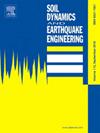Seismic vulnerability analysis of adobe structures considering historical Chinese seismic intensity standards
IF 4.2
2区 工程技术
Q1 ENGINEERING, GEOLOGICAL
引用次数: 0
Abstract
To study and compare the differences in evaluating the vulnerability of adobe structures under different seismic intensity standards, a seismic vulnerability assessment model for adobe structures considering typical international seismic intensity standards was proposed. An instrument intensity clustering cloud model considering multidirectional ground motion synthesis parameters (real array monitoring data within multiple intensity zones) was generated. In different historical periods, several versions of seismic intensity standards have been released by the China Earthquake Administration (CEA) to evaluate the degree of damage to engineering structures. This paper innovatively considers the vulnerability assessment scale of adobe structures considering six versions of the Chinese earthquake intensity standard, and a seismic damage probability model of the adobe structure is established considering the impacts of six destructive earthquakes during different periods (China). A macroscopic intensity and actual vulnerability distribution of adobe structures considering six destructive historical earthquakes were generated. A novel vulnerability prediction model for adobe structures considering the evaluation of historical Chinese intensity standards was proposed via Gaussian process regression and algorithms. Using the actual seismic loss dataset of adobe structures (the Wenchuan earthquake in China) and the proposed vulnerability model, seismic vulnerability prediction curves for adobe structures considering six versions of macrointensity standards were generated. A numerical model of an adobe structure was established using numerical simulation methods. Considering the ground motion parameter values specified in different intensity zones of the three Chinese earthquake intensity standards, dynamic response and failure risk analyses were conducted on the numerical model, and earthquake damage stress clouds were generated. A comparison of different macrointensity scales and regression algorithms revealed that the latest version of the Chinese macrointensity standard (CMS-20) can accurately quantify the seismic intensity level and seismic vulnerability of adobe structures. Gaussian process regression has excellent prediction accuracy and can be used for seismic vulnerability assessment of adobe structures.
考虑中国历史地震烈度标准的土坯结构地震易损性分析
为了研究和比较不同烈度标准下土坯结构易损性评价的差异,提出了考虑国际典型烈度标准的土坯结构地震易损性评价模型。建立了考虑多方向地震动综合参数(多强度区域内实际阵列监测数据)的仪器强度聚类云模型。在不同的历史时期,中国地震局(CEA)发布了几个版本的地震烈度标准来评估工程结构的破坏程度。本文创新性地考虑了六个版本的中国地震烈度标准,建立了土坯结构的易损性评价尺度,并考虑了不同时期(中国)6次破坏性地震的影响,建立了土坯结构的地震损伤概率模型。给出了考虑6次破坏性历史地震的土坯结构宏观烈度和实际易损性分布。基于高斯过程回归和算法,提出了一种考虑中国历史烈度标准评价的土坯结构脆弱性预测模型。利用土坯结构的实际地震损失数据集(中国汶川地震)和提出的易损性模型,生成了考虑6个版本宏观烈度标准的土坯结构地震易损性预测曲线。采用数值模拟方法建立了土坯结构的数值模型。考虑中国三个地震烈度标准中不同烈度区域的地震动参数值,对数值模型进行动力响应和破坏风险分析,生成地震破坏应力云。对不同宏观烈度尺度和回归算法的比较表明,最新版的中国宏观烈度标准(CMS-20)能够准确量化土坯结构的地震烈度等级和地震易损性。高斯过程回归预测精度高,可用于土坯结构的地震易损性评价。
本文章由计算机程序翻译,如有差异,请以英文原文为准。
求助全文
约1分钟内获得全文
求助全文
来源期刊

Soil Dynamics and Earthquake Engineering
工程技术-地球科学综合
CiteScore
7.50
自引率
15.00%
发文量
446
审稿时长
8 months
期刊介绍:
The journal aims to encourage and enhance the role of mechanics and other disciplines as they relate to earthquake engineering by providing opportunities for the publication of the work of applied mathematicians, engineers and other applied scientists involved in solving problems closely related to the field of earthquake engineering and geotechnical earthquake engineering.
Emphasis is placed on new concepts and techniques, but case histories will also be published if they enhance the presentation and understanding of new technical concepts.
 求助内容:
求助内容: 应助结果提醒方式:
应助结果提醒方式:


